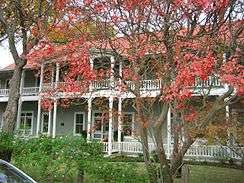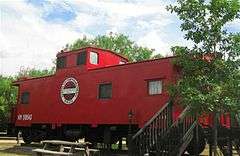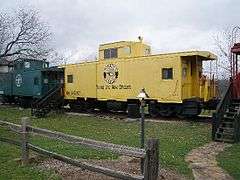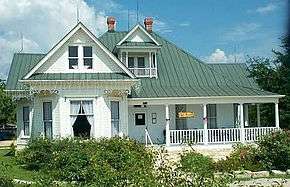Antlers Hotel (Kingsland, Texas)
The Antlers Hotel is a hotel and resort built in 1901 by the Austin and Northwestern Railroad on the Colorado River in Kingsland in Llano County in Central Texas. After a brief heyday, The Antlers closed in 1923 and fell into disrepair. It was eventually resurrected by a couple from Austin, Texas, and reopened in 1996.
| Antlers Hotel | |
|---|---|
%26groups%3D_bd04e3f8b9ca8f6825883d23220343370910402b.svg)
| |
| General information | |
| Location | Kingsland, Texas |
| Address | 1001 King Street |
| Coordinates | 30°39′37″N 98°26′11″W |
| Opening | September 1, 1996 |
| Technical details | |
| Floor count | 2 |
| Other information | |
| Number of rooms | 26 |
| Number of suites | 25 |
| Number of restaurants | 1 |
| Website | |
| The Antlers Hotel website | |
| Constructed in 1901, restored in 1993-1996 | |
The Victorian structure is the centerpiece of what has become an historic railway district. Other railroad buildings have been added, among them a depot and three brightly painted cabooses setting on actual rails which have also been modified to serve as guest accommodations. The transformation continues whenever additional authentic old railroad structures are occasionally found, renovated and added to the resort. In 2002, The Antlers was designated a Recorded Texas Historic Landmark, Marker No. 15150.[1]
History of Kingsland and construction of the hotel
In 1892, the Austin and Northwestern Railroad constructed a bridge across the Colorado River and a depot in Kingsland south of the point where the Colorado River meets the Llano River. The Antlers Hotel was begun in 1900 and opened on May 1, 1901.[2] Framed newspapers hanging around the hotel show events on that date including the cross-country trip by U.S. President William McKinley, who toured Austin by train on May 3, 1901. He was assassinated in Buffalo, New York, a few months later on September 5.
The Antlers Hotel

The Antlers Hotel was named in part for the Antlers Hotel in Colorado Springs, Colorado,[3] a new and fashionable railroad resort that opened a few years earlier. The Antlers is also named because Llano County was and remains a deer hunting area.[4]
The hotel had all the modern conveniences of the day, including gas lights and a telephone in the lobby. The owners thought that electricity was a passing fad. All the camps had telephones so that guests could call in orders to the hotel kitchen. The hotel had eleven rooms with expansion capability for additional guests by placing hammocks on the wide porches. The hotel was in the center of a campground known as Campa Pajama that stretched down to Crescent Lake, formed by a 1,000 foot lock across the Colorado River. The lock was later destroyed in a flood. The since-renamed Lake LBJ was created in 1951 with the construction of the Wirtz Dam.[5]
Antlers Historic Railroad District


The area around the hotel has been designated as an historic railroad district. Many of the building relate to the rail lines that still exist in front of the hotel. To the west of the hotel is a bunkhouse that was used by hotel staff and train crews. Just north of the bunkhouse is a small three-room cabin that was typical of several cabins spaced around the property. The architectural details of the hotel, bunkhouse, and cabin indicate that all were built at the same time. Across the road from the bunkhouse is the house of the Section Master who presided over a section of the railroad. This house was bought from the Southern Pacific Railroad in the 1940s. The Kingsland Depot was directly in front of the hotel between the main line and the sidetrack that still exist. In the field in front of the hotel, which is now the parking lot of the Grand Central Cafe and Club Car Bar, was a large wooden pavilion used for dances and community gatherings.[6]
Early 1900s history
1900 and 1901 were a time of consolidations in the railroad industry. The Austin and Northwestern Railroad[7] had begun construction of the hotel and by the time it opened in 1901, the railroad and its hotel had been acquired by the Houston and Texas Central Railroad.[8] The cast iron pot-belly stove in the dining room carries the H&TCR logo for the Houston and Texas Central Railroad, which was itself acquired by the Texas and New Orleans Railroad and then the Southern Pacific Railroad.
The hotel was a fashionable resort and on weekends the railroad ran an excursion train out from Austin for a $1.50 round trip fare.[9] The hotel also served traveling salesmen or "drummers"[10] and cattlemen. The hotel operated successfully until the 1920s when automobile travel eroded the reliance on train excursions. The novelty of the lake by the rails faded as a vacation destination and the hotel closed in 1923.
Restoration
A fire destroyed much of Kingsland in 1922,[11] and the town fell into decline. The property was purchased in 1923 by the Barrow family of Austin, who used it as a private family retreat for seventy years until 1993, at which time the hotel itself had fallen into disrepair.[9]
The hotel was purchased in 1993 by an Austin couple who worked for more than two years in its restoration. It reopened on September 1, 1996, with Lori and Anthony Mayfield, the master carpenter on the restoration, as the managers. In addition to the restored hotel, there are several renovated cabins, a depot, and three colored cabooses (formerly of the Norfolk and Western Railroad) which are also used as guest accommodations.[12] There is also a conference room, and other turn-of-the-century buildings. The hotel has become a center of restoration and growth for the area.[9] The Antlers is located on fifteen acres of land.

The former "Texas Chainsaw" House
The Texas Chainsaw House (now the "Grand Central Cafe and Club Car Bar" restaurant) http://www.kingslandgrandcentral.com is a Victorian house now located on the grounds of the Antlers Hotel and was used in the filming of The Texas Chain Saw Massacre during 1973, when it was still in its original location.[13] The house then sat vacant and fell into disrepair. In 1993 it was moved from the La Frontera[14] development in Williamson County by the owners of the hotel. Once on site it was extensively renovated and converted into a restaurant.[15]
References
- "THC Antlers Hotel-Kingsland". Recorded Texas Historic Landmark. Texas State Historical Commission. Retrieved 18 February 2011.
- "Kingsland Texas". Texas Handbook Online. Retrieved 3 February 2011.
- "Antlers Hotel Colorado Springs". Archived from the original on 2010-09-13.
- "Llano Texas, The Deer Capital of Texas (The Llegend of Llano)". Texas Hill County.com. Archived from the original on 19 March 2011. Retrieved 8 February 2011.
- "Wirtz Dam and Lake LBJ". Lower Colorado River Authority.
- "Antlers Hotel History".
- "Austin and Northwestern Railroad". Handbook of Texas Online. Retrieved 3 February 2011.
- "Texas and Central Railway". Texas Handbook of Texas Online. Retrieved 3 February 2011.
- Mike Cox (July 13, 2006). "TexasEscapes: The Antlers". TexasEscapes.com. Retrieved 3 February 2011.
- Dr. Robert Long (3 February 1006). "Drummers, Canvassers, and Knockers". Word Wealth. Archived from the original on 5 July 2011. Retrieved 4 February 2011.
- Darla Sue Dollman (6 February 2010). "Kingsland Texas - a Short History of a Small Texas Town". Suite 101 Publisher. Archived from the original on 23 June 2015. Retrieved 3 February 2011.
- "Stay in a Railroad Cabosse". Retrieved 4 February 2011.
- "Film Locations for the Texas Chainsaw Massacre". Worldwide Guide to Film Locations. Retrieved 5 February 2011.
- "Howdy Neighbor, can I borrow your saw?". Austin American-Statesman. July 2, 1999.
- Pack, MM (2003-10-23). "The Killing Fields: A culinary history of 'The Texas Chainsaw Massacre' farmhouse". The Austin Chronicle. Retrieved 2011-02-02.